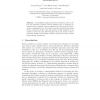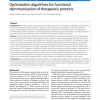119 search results - page 22 / 24 » Weave amino acid sequences for protein secondary structure p... |
BMCBI
2008
13 years 7 months ago
2008
Background: A multiple sequence alignment (MSA) generated for a protein can be used to characterise residues by means of a statistical analysis of single columns. In addition to t...
RECOMB
2006
Springer
14 years 7 months ago
2006
Springer
Abstract. A probabilistic graphical model is developed in order to detect the dependent evolution between different sites in biological sequences. Given a multiple sequence alignme...
BMCBI
2010
13 years 7 months ago
2010
Background: Sequence alignments form part of many investigations in molecular biology, including the determination of phylogenetic relationships, the prediction of protein structu...
BMCBI
2010
13 years 7 months ago
2010
Background: To develop protein therapeutics from exogenous sources, it is necessary to mitigate the risks of eliciting an anti-biotherapeutic immune response. A key aspect of the ...
BMCBI
2010
13 years 7 months ago
2010
Background: G-protein-coupled receptors (GPCRs) play a key role in diverse physiological processes and are the targets of almost two-thirds of the marketed drugs. The 3 D structur...


